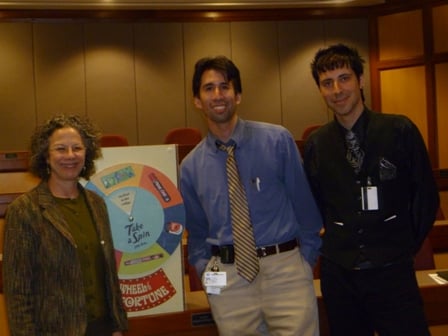 |
|
| Presenters Tina Grosowsky (left) and Ryan Coffman (right) are pictured here with host Joshua Blum, MD, chief psychiatry resident (center), at a tobacco training seminar for psychiatry residents. | |
|
Deceptive and dangerous cigarette alternatives The following was excerpted from information provided by the Massachusetts Department of Public Health’s OPPOSE Underhanded Tobacco Tactics (www.oppose.ning.com) campaign.
Other novel nicotine products include a topically applied skin gel and lollipops. The adverse health effects of all of them are the same as, and in some cases potentially worse than, those of cigarettes. |
More than a thousand Americans quit smoking each day—by dying, often of tobacco-induced illnesses such as lung cancer, heart disease and stroke. Despite decades during which knowledge of the dangers of tobacco use has increased, and the number of Americans who smoke has decreased, attendant health problems of tobacco use continue at epidemic proportions domestically and pandemic proportions worldwide.
One major reason that tobacco use continues worldwide is that the tobacco industry, which has a vested interest in hooking new users of nicotine, maintains a steady pipeline of new products that appear to be designed to attract the youngest new tobacco users, as well as individuals living with a psychiatric disorder, who the industry hopes will spend a lifetime consuming tobacco. The industry also offers alternatives to smokers so that they can consume nicotine wherever they go, even in locations where smoking is prohibited.
On Thursday, Feb. 23, the adult psychiatry residents at UMass Medical School had their eyes opened by a presentation on the newest, most insidious tobacco products now on the market. “Mental health professionals are at the forefront of combating the tobacco epidemic,” said Ryan Coffman, MPH, tobacco treatment specialist and director of the UMass Tobacco Consultation Service in the Department of Psychiatry. “Training the next generation of psychiatrists about tobacco use and treatment is vital as they care for individuals living with psychiatric disorders, a population that bears an enormous physical, psychological, financial and social burden from tobacco use.”
Presenting along with Coffman was Tina Grosowsky, project coordinator for the Central Massachusetts Tobacco-Free Community Partnership. Led by the Department of Psychiatry, the partnership is one of eight regional collaborations statewide that are funded by the Massachusetts Department of Public Health’s Tobacco Cessation and Prevention Program to help link local communities to state resources for tobacco intervention.Following a brief history of tobacco use, marketing and legislation in the United States, the residents were introduced firsthand to each product as Coffman and Grosowsky not only described them, but passed around actual samples (see sidebar).
In addition to introducing tobacco training to psychiatry residents, UMass Medical School, an innovator in research and training for the prevention, treatment and cessation of tobacco use, provides numerous educational resources for graduate students, practicing clinicians and community agencies. These include the Center for Tobacco Treatment Research and Training, and the Addressing Tobacco Through Organizational Change Consultation and Training Institute; and a new Inpatient Tobacco Consultation Shadowing Experiencefor School of Medicine students. “The positive feedback from medical students who have engaged this opportunity during their rotation has been overwhelming,” Coffman noted. “We are grateful that the Department of Psychiatry has made this experience a priority.”